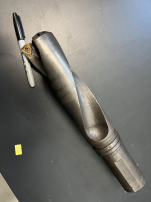Not complaining, just thought it was interesting. I bet it's something of a tossup when you figure in all the other factors, with the light weight machine maybe (probably ?) coming out cheaper.
But on a lathe, that's a different story

In the case of my 2005 kitamura hx400if, it's a 400mm box way 40 taper HMC, 13k gear driven spindle, might be 20 or 25hp? 30? I don't recall. Has big plus spindle.
But looking at the load meters, Couldn't get close to the type of ipr that 1.75" drill needed. Was ~200% at .010" per rev, but I initially started out at .014 (which is also low) and spiked out at over 250%. Spindle load was ~90%
Not sure what the motors and drives are rated to but the machine was built to go fast and accurate (1968 rapids). And while the machine is stout and the spindle is pretty good down low, I would certainly not call it a powerful machine
And an 5X wouldn't be a lot beefier, if at all (besides having the cat50 spindle taper)
I almost wonder if the z thrust was pushing the tombstone back, causing the carriage to lift and get cocked on the ways, causing a lot more force to be required to slide it forward. It probably contributed to it somewhat.
I will say, I'm going 60 inches per minute, .030" stepdown, 1.75 hole with a 1" tool on that 321 stainless.
So the tool travels 2.35" per lap around. And I take 40 laps down to a depth of 1.2". That's about 94 seconds per hole.
Obviously you would tailor it to whatever feedmill you are going to run, but we run iscar, and my guess to start out at based on my a514 experience would be a 1.25 tool, 4 inserts, maybe 300sfm (900rpm), .025ipt, which would be 90 per minute.




